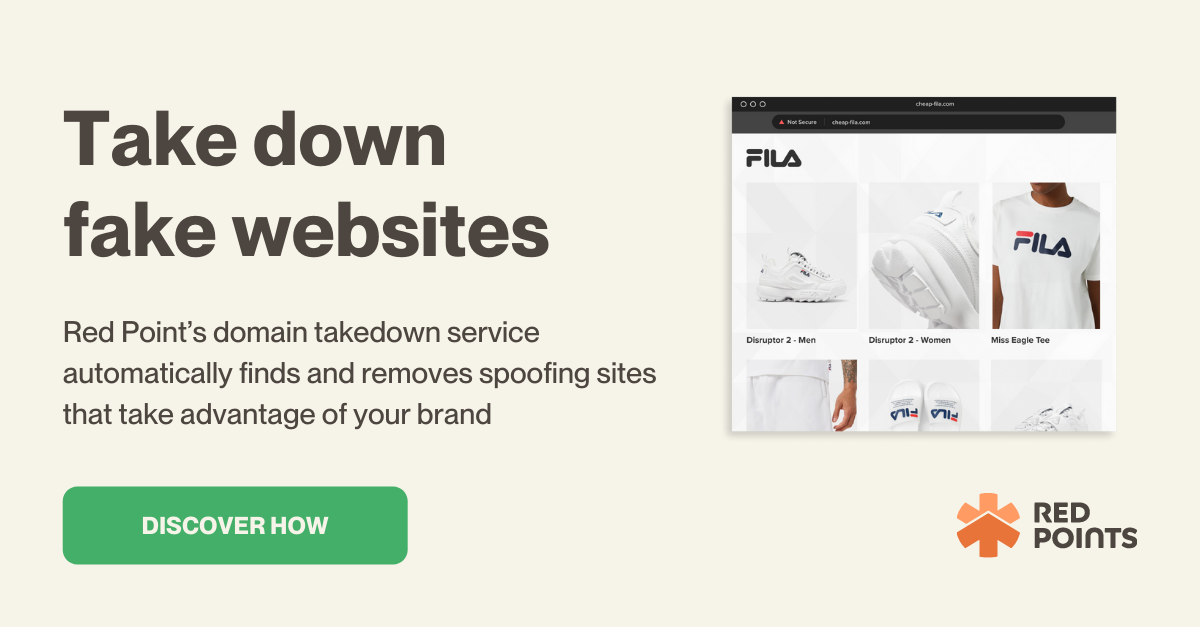Scam websites are more common today than ever before. A recent study revealed that around 8.3% of all websites are scams. Unfortunately, the internet is plagued with bad actors and scammers who are looking to take advantage of online businesses and users with a variety of digital scams.
The evolving world of artificial intelligence (AI) is making it easier for scammers to create sophisticated scam websites at scale. To ensure that you can protect your brand, your intellectual property, and your customers you have to learn how to identify, report and remove scam websites.
The best way to combat such websites is by investing in the right technological solutions. Here we explore how to report a scam website by highlighting a few key topics:
- What is a scam website?
- How to identify a scam website
- How to report a scam website: step-by-step guide
- How to optimize the process of reporting scam websites at scale

What is a scam website?
Scam websites are fraudulent internet sites created by bad actors to trick users. They are used to gain access to sensitive information, distribute malware, mask intentions, and steal money.
Scam websites are a threat to businesses as well as users. They will target businesses by using copyrighted material without permission, by posing as a legitimate business website, and by targeting specific customer bases.
Here are a few of the key characteristics of a scam website:
- Suspicious domain names – Scam websites often have strange, convoluted, or lengthy domain names. They may also have domain names very similar to the names of legitimate websites and brands.
- Poor grammar and design issues – You can spot a scam website by looking at the details. Often, the website will have an awkward user interface (UI) and it will be littered with grammatical errors. Recently, some scammers have been using AI programs to limit these issues but the majority of scam websites can still be characterized by sloppy copy and design.
- Suspicious links – Some scam websites will fill their pages with links in the hopes that users will click on them. These links often lead to malicious content or malware.
- Blatant copying – Fraudulent websites will often be quite obvious in the way they copy the imagery, messaging, and features of legitimate brands. This is a key sign that you are interacting with a scam website and you should steer clear.
- Offers that are too good to be true – If you believe an offer on a website is too good to be true it most likely is. Scammers use attractive offers and deals on their websites to entice clicks and take advantage of users.
- Unrealistic user reviews or no reviews – A series of overly positive and extremely similar reviews are usually a sign of inauthenticity. Today, some scammers are using AI tools to make fake reviews sound more realistic so this characteristic is often not as easy to spot as it used to be. Alternatively, no user reviews and no tools to provide feedback are also common for scam websites.
- No security label – Most verified, legitimate websites have a security label or trust badge in the web browser bar. This padlock icon is one of the signs that you are dealing with a trusted website. Some scammers may forge these icons to appear legitimate. However, in most cases, a scam website will lack a security label.
How to identify a scam website
Scam websites are at their most dangerous when they can function discreetly and under the guise of legitimacy. It is important for businesses of all kinds to know how to spot online scams and other fraudulent website activity. Here are a couple of key methods businesses can use to identify a scam website:
- Manual keyword and image searches
If you are worried that your brand is being affected by scam websites, you can conduct manual online searches to identify dodgy sites. Often scam websites may be using your copyrighted material to carry out their scams.
Use search engines like Google to execute searches based on keywords and images associated with your brand. If you see that your content is being used on a website that you do not recognize then you may have found a scam website that is targeting your brand. Also, keep an eye out for website trust seals and certificates.
This search method will help you uncover scam websites that are trying to take advantage of consumers who are looking for your legitimate website. However, while effective at a small scale, this method of identification is expensive and impractical when you are dealing with large-scale scam website issues.
- Online customer interactions
Ask your customers about their online experiences. Have they encountered any websites that are spoofing your brand? Have they bought one of your products from a third-party website? Have they noticed any strange promotions or links on social media that purport to be connected to your brand?
Keeping open lines of communication with your online customers is a great way to speed up the process of identifying scam websites. It is impossible for your business to constantly patrol the web for scammers on your own. You need to rely on other parties for information.
Customers are a useful source of information on scammers because they are often the primary target for scam websites. By communicating with them on a regular basis, via emails, social media, and your website, you will be able to safeguard them and your brand from scam websites.
How to report a scam website: Step-by-step guide
To ensure that your business is protected from scam websites you need to report them to the appropriate platform or authority as soon as possible. With fraudulent or malicious online activity there are a few different ways to seek removal. Nearly all methods will require you to gather evidence including URLs, screenshots, and records of correspondence.
Below we’ve highlighted how you can report a scam website to different platforms like web hosts and search engines as well as authorities like the Federal Trade Commission (FTC).
Report to the Federal Trade Commission
- Step 1 – Head over to ReportFraud.ftc.gov and begin your report
- Step 2 – Select your reason for reporting (e.g. Online Shopping for websites selling counterfeit goods)
- Step 3 – Provide evidence including details about the website, records of interactions and any damage suffered
- Step 4 – Provide details about you or your business
- Step 5 – Submit the report
Report to a Search Engine
- Step 1 – Visit the search engine’s report portal or page
- Step 2 – Select the reason for reporting the website
- Step 3 – Provide evidence such as the URL, screenshots, and additional details
- Step 4 – If you believe the scam website has infringed your IP then submit evidence of the work and your brand’s ownership
- Step 5 – Sign and submit the report
Report to the Website Host
- Step 1 – Identify the website host by visiting lookup.icann.org and entering the domain name of the scam website
- Step 2 – Contact the website host via email or by filing a report form. Include all relevant details about the scam website and the situation
Report links to scam websites on Social Media
- Step 1 – Locate the Help/Report Center for the social media platform (see below examples of Instagram’s Portal)
- Step 2 – Note where you found the scam link within the social media platform e.g. a post, message, or advert
- Step 3 – Select the type of infringing activity contained within the link e.g. abuse, spam, or intellectual property infringement
- Step 4 – Provide your contact information (Apart from IP reports, most complaints on social media can be filed anonymously)
- Step 5 – Provide the infringing link, outline why you are reporting and include all the relevant details
- Step 6 – Sign and submit
How to optimize the process of reporting scam websites at scale
You can begin to protect your business from scam websites by filing reports on search engines and pursuing infringers via legal routes. This can be an effective strategy when you are dealing with isolated incidents and unsophisticated infringers. However, when you are faced with scam websites at scale and you have to fight organized scammers, this manual method is not an efficient or cost-effective option.
Red Points’ Domain Takedown Service can solve this issue for you. Our solution automatically finds and removes spoofing sites that target your brand. Powered by first-class technology and supported by industry expertise, we have an 80% enforcement success rate against scam websites. Here’s how we do it:
- Find
Our bots crawl the web to detect scam websites. We use technology to scour social media, search engines, and domain databases with precision to ensure we can find malicious or fraudulent online activity.
Through automation we are able to search widely and deeply, uncovering scam websites that may have slipped under your radar during a manual search.
- Remove
After we have located the scam website, we immediately move to report the domain. We send detailed and effective reports to the relevant party whether that be the domain registrant, the CMS platform, or the server host.
- Measure
Our advanced scam website takedown services, supported by IP experts, are trained at automatically identifying stand-alone sites requiring intervention. We maintain an API connection with exclusive domain databases, including deep web resources, ensuring our data is updated daily for maximum effectiveness. Additionally, our system continuously crawls the surface web through search engines like Google, enabling us to rapidly detect thousands of phishing domains. The integration of machine learning further enhances our capability, as it continuously learns from our takedown history, progressively improving the detection of scam websites over time. This sophisticated approach ensures a robust and evolving defense against online threats.
With over 1,200 clients worldwide, we are equipped to deal with businesses from a wide variety of industries. On average we take 1-7 days to remove scam or malicious domains. This allows you to quickly safeguard your online business operations and mitigate the impact of any scam websites. Your business and your customers will then be able to operate online with confidence.
What’s next
Detecting scam websites is the first step your business can take towards shutting them down and protecting your customers. With the proliferation of accessible AI technology, scammers are producing more deceptive, adaptable, and effective scam websites every day. While you can try to tackle this problem in-house with manual techniques, if you want to succeed you need to fight fire with fire and rely on the best tech available.
An automated, specialized domain takedown solution is the best way of how to take down a fake website. With these kinds of solutions, you can proactively and efficiently remove scam websites and protect your business online.
Alongside investing in the best tech, you should also seek to establish a strong online brand presence for your business. This will help you build robust customer connections online and allow you to confront online threats from a position of strength. To learn more about how Red Points can help you deal with scam websites, request a demo here.












